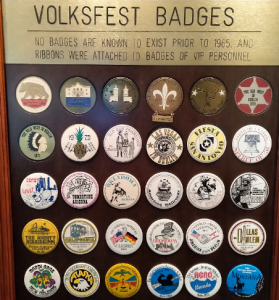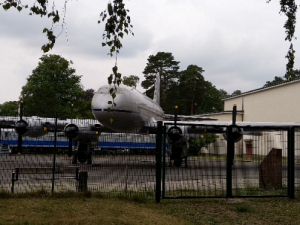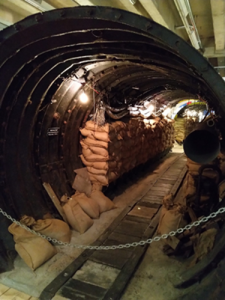There are any number of feature films and documentaries about the Cold War, some of which have been shown in numerous movie theaters over the decades. But there is likely only one museum about the Cold War that is housed in a repurposed movie theater: the Allied Museum in Berlin’s Dahlem district.

The Allied Museum, located near the U.S. Embassy on Clayallee, in the heart of the former American forces sector, tells the contemporary history of “how Berlin became what it is today.” The focus is on the period 1945 (the German surrender) to 1994, which marks the withdrawal of American troops from the reunified capital. Housed since 1998 in the historic Outpost movie theater along with several ancillary structures, the Museum conveys much of the drama of these decades in a chronological exhibit covering the divided city’s political, economic, social, and cultural development. Given the complexity of the era, each of these areas are touched on relatively briefly with an emphasis on the coordinated efforts of Western Allies and the events of the Berlin Blockade.
The exhibit begins the story of post-WWII Berlin in the foyer, documented in German, English, French, and Russian newspapers proclaiming the end of armed conflict. The mixed reactions of Berliners – expressing relief, resentment, and fears for the future – are superimposed on images taken as troops entered the city.
Entering the main exhibition space – the former viewing room – visitors are confronted not just with a meticulous documentation of the rising tensions in the immediate post-war years, but also with the opportunity to engage with some of the more challenging dilemmas of the era. Interactive screens offer multiple perspectives of Berliners whose opinions about the military presence (and later, military withdrawal) are reflected in various colors and languages in a series of fading and re-appearing texts in connection with historic images. Visitors are encouraged to weigh in on the process of denazification, writing on a postcard how they would gauge its success.

From there, a mixture of newspaper and magazine articles, personal souvenirs, and audio-visual sequences describe early reconstructive efforts (the European Recovery Plan) and efforts to promote democracy and friendship among the Western Allies and the German citizenry through radio, education, and goodwill initiatives. Mementos and souvenirs that document the budding ties between American soldiers and German citizens are in the middle aisle, flanked by information about the Allied administration of the city on one side and military regalia, including an actual Willys MB jeep that looks like it is straight out of a movie prop storeroom, on the other.
Visitors access the former stage via two arched walkways that narrate attempts to create normalcy amid the crisis that reached its climax in the Berlin Blockade. A timeline details events from 1945 to 1949; the stage itself is given over to documents, images, videos, and correspondence detailing the complexity and heroism of the Blockade itself. What was originally the orchestra pit is now filled with sacks representing a small portion of the coal that was transported during this massive undertaking that saw a total of 1.58 million tons of coal flown into the besieged Western sectors.
The exhibit continues in the Nicholson Library, which is on the far side of a Hastings TG503 raisin bomber that visitors can board on Sundays in the summer. There is also a GDR-era guard tower, a Checkpoint Charlie border crossing building, and a French military dining car on the premises, the latter two of which can also be toured.

The emphasis in the Nicholson Library is on the era of the Wall and the tenuous peace of these years. A piece of the Berlin Wall is de rigueur. Additionally, there are remnants of the Allied Forces presence in a variety of forms: A British phone booth, the original Checkpoint Charlie guardhouse, and a restored section of the infamous 1953 spy tunnel  join newspapers, license plates, and a replica of the U.S. Consulate made out of sugar.
join newspapers, license plates, and a replica of the U.S. Consulate made out of sugar.
Special exhibits share this space with a small bookshop and a seating area. Currently, a photography installation documents the life of Armed Forces’ dependents in Germany’s “Little America,” which played out in the streets next to the current Museum. In addition to tours of the exhibit(s) and the outbuildings, the Museum offers special events and (mostly German-language) tours both of the Museum itself and Cold War Berlin.
The museum is physically accessible, and written information is provided in French, German, and English. Unlike the movies that used to be shown there, admission is free. Plans are underway for the Museum to move to the old Tempelhof Airport in 2021.
17,993 Total Views, 6 Views Today






